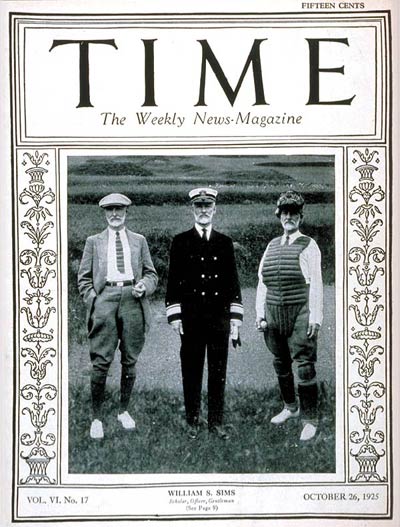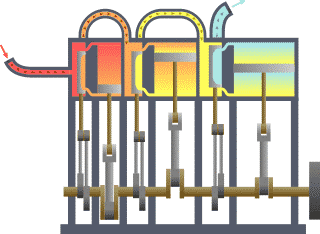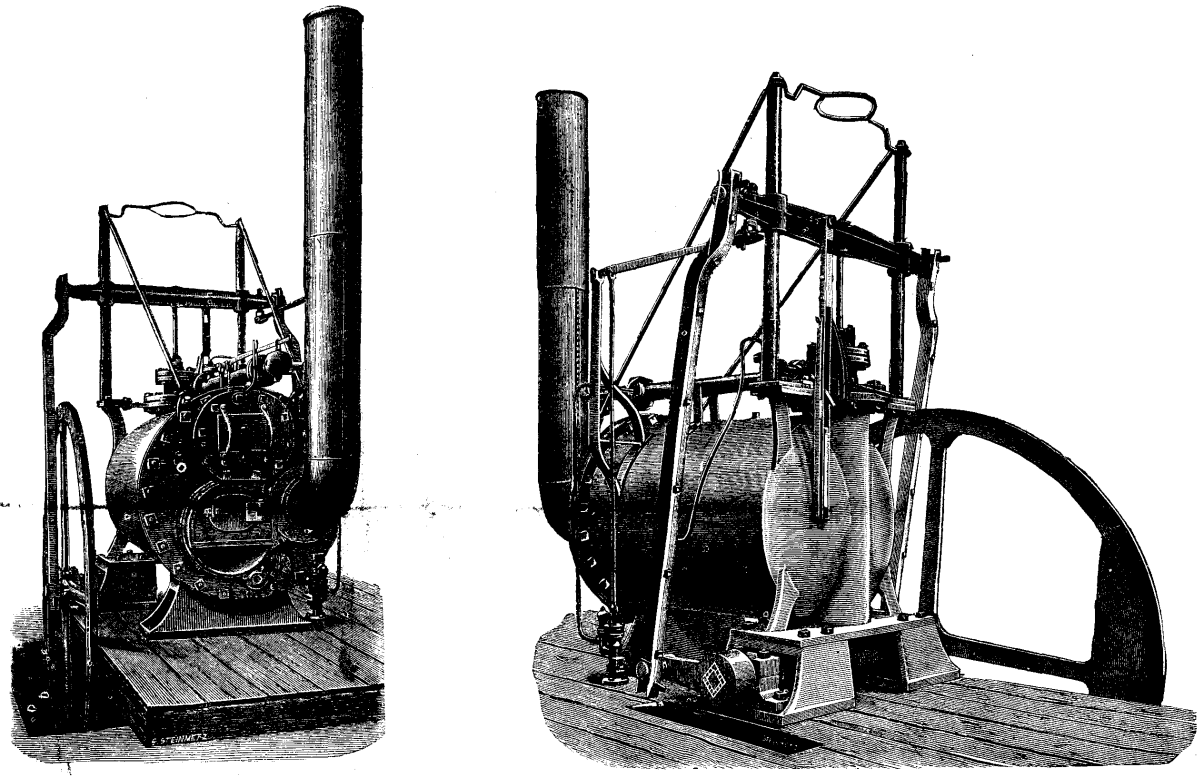|
Cornish Engine
A Cornish engine is a type of steam engine developed in Cornwall, England, mainly for pumping water from a mine. It is a form of beam engine that uses steam at a higher pressure than the earlier engines designed by James Watt. The engines were also used for powering man engines to assist the underground miners' journeys to and from their working levels, for winching materials into and out of the mine, and for powering on-site ore stamping machinery. Background Cornwall has long had tin, copper and other metal ore mines, but if mining is to take place at greater depths, a means to dewater the mine must be found. Lifting the weight of water up from the depths requires great amounts of work input. This energy may be weakly supplied by horse power or a waterwheel to operate pumps, but horses have limited power and waterwheels need a suitable stream of water. Accordingly, the innovation of coal-fired steam power to work pumps was more versatile and effective to the mining ind ... [...More Info...] [...Related Items...] OR: [Wikipedia] [Google] [Baidu] |
Pumping Engine Cruquius
Pumping may refer to: * The operation of a pump, for moving a liquid from one location to another **The use of a breast pump for extraction of milk * Pumping (audio), a creative misuse of dynamic range compression * Pumping (computer systems), the number of times data is transmitted per clock cycle * Pumping (oil well), injecting chemicals into a wellbore * Pumping (noise reduction), an unwanted artifact of some noise reduction systems * Pumping lemma, in the theory of formal languages * Gastric lavage, cleaning the contents of the stomach * Optical pumping, in which light is used to raise electrons from a lower energy level to a higher one * Pump (skateboarding), accelerating without pushing off of the ground * Pumping (My Heart), "Pumping" (My Heart), a 1976 song by Patti Smith Group {{disambiguation ... [...More Info...] [...Related Items...] OR: [Wikipedia] [Google] [Baidu] |
Valve Gear
The valve gear of a steam engine is the mechanism that operates the inlet and exhaust valves to admit steam into the cylinder and allow exhaust steam to escape, respectively, at the correct points in the cycle. It can also serve as a reversing gear. It is sometimes referred to as the "motion". Purpose In the simple case, this can be a relatively simple task as in the internal combustion engine in which the valves always open and close at the same points. This is not the ideal arrangement for a steam engine, though, because greatest power is achieved by keeping the inlet valve open throughout the power stroke (thus having full boiler pressure, minus transmission losses, against the piston throughout the stroke) while peak efficiency is achieved by only having the inlet valve open for a short time and then letting the steam expand in the cylinder (expansive working). The point at which steam stops being admitted to the cylinder is known as the '' cutoff'', and the optimal posit ... [...More Info...] [...Related Items...] OR: [Wikipedia] [Google] [Baidu] |
Transactions Of The Newcomen Society
The Newcomen Society is an international learned society that promotes and celebrates the history of engineering and technology. It was founded in London in 1920,The Newcomen Society. '' Journal of the Royal Society of Arts'' 72 (3709): 84 (1923) and takes its name from Thomas Newcomen, one of the inventors associated with the early development of the steam engine and who is widely considered the "father of the Industrial Revolution". An early president was Loughnan St. L. Pendred. The society is concerned with all branches of engineering: civil, mechanical, electrical, electronic, structural, aeronautical, marine, chemical and manufacturing as well as biography and invention. The Newcomen Society is based at the Science Museum in London. There are regional branches in England: Midlands (Birmingham), North West (Manchester), North East (Newcastle), Western (Bristol) and Southern (Portsmouth), South Yorkshire (Sheffield) and one in Scotland (Glasgow and Edinburgh). It publi ... [...More Info...] [...Related Items...] OR: [Wikipedia] [Google] [Baidu] |
Woolf Compound Engine
Arthur Woolf (1766, Camborne, Cornwall – 16 October 1837, Guernsey) was a Cornish engineer, most famous for inventing a high-pressure compound steam engine. In this way he made an outstanding contribution to the development and perfection of the Cornish engine. Woolf left Cornwall in 1785 to work for Joseph Bramah's engineering works in London. He worked there and at other firms as an engineer and engine builder until 1811 experimenting with high pressure steam and a much improved boiler. He then returned to Cornwall. Michael Loam, who introduced the man engine to the UK, was trained by him. When he returned to Cornwall, beam engine designs were crude, shackled by outdated Watt patents and poor engineering, struggling to compete with large water wheels, even used underground. He learned from Bramah that to move forward meant adopting much improved engineering techniques, for it was Bramah who invented quality control. Woolf was chief engineer to Harvey & Co of Hayle, the le ... [...More Info...] [...Related Items...] OR: [Wikipedia] [Google] [Baidu] |
Atmospheric Pressure
Atmospheric pressure, also known as air pressure or barometric pressure (after the barometer), is the pressure within the atmosphere of Earth. The standard atmosphere (symbol: atm) is a unit of pressure defined as , which is equivalent to 1,013.25 millibars, 760 mm Hg, 29.9212 inchesHg, or 14.696 psi.International Civil Aviation Organization. ''Manual of the ICAO Standard Atmosphere'', Doc 7488-CD, Third Edition, 1993. . The atm unit is roughly equivalent to the mean sea-level atmospheric pressure on Earth; that is, the Earth's atmospheric pressure at sea level is approximately 1 atm. In most circumstances, atmospheric pressure is closely approximated by the hydrostatic pressure caused by the weight of air above the measurement point. As elevation increases, there is less overlying atmospheric mass, so atmospheric pressure decreases with increasing elevation. Because the atmosphere is thin relative to the Earth's radius—especially the dense atmospheric layer at low altitu ... [...More Info...] [...Related Items...] OR: [Wikipedia] [Google] [Baidu] |
William Sims (engineer)
William Sowden Sims (October 15, 1858 – September 28, 1936) was an admiral in the United States Navy who fought during the late 19th and early 20th centuries to modernize the navy. During World War I, he commanded all United States naval forces operating in Europe. He also served twice as president of the Naval War College. Career Sims was born to American father Alfred William (1826–1895) and Canadian mother Adelaide (née Sowden; b. 1835) living in Port Hope, Canada West. He graduated from the United States Naval Academy in 1880, the beginnings of an era of naval reform and greater professionalization. Commodore Stephen B. Luce founded the Naval War College in Newport, Rhode Island in 1884, to be the service's professional school. During the same era, Naval War College instructor Captain Alfred Thayer Mahan was writing influential books on naval strategy and sea power. In March 1897, shortly after his promotion to lieutenant, Sims was assigned as the military attaché t ... [...More Info...] [...Related Items...] OR: [Wikipedia] [Google] [Baidu] |
Economic History Review
''The Economic History Review'' is a Peer review, peer-reviewed history journal published quarterly by Wiley-Blackwell on behalf of the Economic History Society. It was established in 1927 by Eileen Power and is currently Editor-in-chief, edited by Sara Horrell, Jaime Reis and Patrick Wallis. Its first editors were Ephraim Lipson, E. Lipson and R. H. Tawney and other previous editors include Michael Postan, M. M. Postan, John Habakkuk, H. J. Habbakuk, Max Hartwell (1960–1968), Christopher Dyer, Nicholas Crafts, John Hatcher, Richard Smith, Jane Humphries, Steve Hindle and Phillipp Schofield. Edition The lead editors are John Turner, Giovanni Federico and Tirthankar Roy. The editorial board counts 21 other editors, including Jane Humphries and Debin Ma from the University of Oxford and Sara Horrell, Max-Stephan Schulze and Patrick Wallis from the London School of Economics. The journal has published 75 volumes usually composed of 4 annual issues. Ranking It is considered one o ... [...More Info...] [...Related Items...] OR: [Wikipedia] [Google] [Baidu] |
Compound Steam Engine
A compound steam engine unit is a type of steam engine where steam is expanded in two or more stages. A typical arrangement for a compound engine is that the steam is first expanded in a high-pressure (HP) cylinder, then having given up heat and losing pressure, it exhausts directly into one or more larger-volume low-pressure (LP) cylinders. Multiple-expansion engines employ additional cylinders, of progressively lower pressure, to extract further energy from the steam. Invented in 1781, this technique was first employed on a Cornish beam engine in 1804. Around 1850, compound engines were first introduced into Lancashire textile mills. Compound systems There are many compound systems and configurations, but there are two basic types, according to how HP and LP piston strokes are phased and hence whether the HP exhaust is able to pass directly from HP to LP ( Woolf compounds) or whether pressure fluctuation necessitates an intermediate "buffer" space in the form of a steam c ... [...More Info...] [...Related Items...] OR: [Wikipedia] [Google] [Baidu] |
Arthur Woolf
Arthur Woolf (1766, Camborne, Cornwall – 16 October 1837, Guernsey) was a Cornish engineer, most famous for inventing a high-pressure compound steam engine. In this way he made an outstanding contribution to the development and perfection of the Cornish engine. Woolf left Cornwall in 1785 to work for Joseph Bramah's engineering works in London. He worked there and at other firms as an engineer and engine builder until 1811 experimenting with high pressure steam and a much improved boiler. He then returned to Cornwall. Michael Loam, who introduced the man engine to the UK, was trained by him. When he returned to Cornwall, beam engine designs were crude, shackled by outdated Watt patents and poor engineering, struggling to compete with large water wheels, even used underground. He learned from Bramah that to move forward meant adopting much improved engineering techniques, for it was Bramah who invented quality control. Woolf was chief engineer to Harvey & Co of Hayle, ... [...More Info...] [...Related Items...] OR: [Wikipedia] [Google] [Baidu] |
Richard Trevithick
Richard Trevithick (13 April 1771 – 22 April 1833) was a British inventor and mining engineer. The son of a mining captain, and born in the mining heartland of Cornwall, Trevithick was immersed in mining and engineering from an early age. He was an early pioneer of steam-powered road and rail transport, and his most significant contributions were the development of the first high-pressure steam engine and the first working railway steam locomotive. The world's first locomotive-hauled railway journey took place on 21 February 1804, when Trevithick's unnamed steam locomotive hauled a train along the tramway of the Penydarren Ironworks, in Merthyr Tydfil, Wales. Turning his interests abroad Trevithick also worked as a mining consultant in Peru and later explored parts of Costa Rica. Throughout his professional career he went through many ups and downs and at one point faced financial ruin, also suffering from the strong rivalry of many mining and steam engineers of the day. D ... [...More Info...] [...Related Items...] OR: [Wikipedia] [Google] [Baidu] |
East Pool Mine
East Pool mine (later known as East Pool and Agar mine), was a metalliferous mine in the Camborne and Redruth mining area, just east of the village of Pool in Cornwall. Worked from the early 18th century until 1945, first for copper and later tin, it was very profitable for much of its life. Today the site has two preserved beam engines and is part of the Cornwall and West Devon Mining Landscape World Heritage Site. It is owned by the National Trust. Geology The country rock at the mine is metamorphosed killas and greenstone overlying the Carn Brea granite. The many lodes on the sett are all crossed by several elvan dykes. The mine's main produce was copper and later tin, arsenic and wolframite, also small amounts of the ores of bismuth, cobalt and uranium.Burt et al. 1987, pp. 383–389 History to 1900 East Pool mine started out in the early 18th century as a copper mine called "Pool Old Bal". The land under which it was allowed to mine (the "sett") was leased from the Bass ... [...More Info...] [...Related Items...] OR: [Wikipedia] [Google] [Baidu] |
Single- And Double-acting Cylinders
In mechanical engineering, the cylinders of reciprocating engines are often classified by whether they are single- or double-acting, depending on how the working fluid acts on the piston. Single-acting A single-acting cylinder in a reciprocating engine is a cylinder in which the working fluid acts on one side of the piston only. A single-acting cylinder relies on the load, springs, other cylinders, or the momentum of a flywheel, to push the piston back in the other direction. Single-acting cylinders are found in most kinds of reciprocating engine. They are almost universal in internal combustion engines (e.g. petrol and diesel engines) and are also used in many external combustion engines such as Stirling engines and some steam engines. They are also found in pumps and hydraulic rams. Double-acting A double-acting cylinder is a cylinder in which the working fluid acts alternately on both sides of the piston. In order to connect the piston in a double-acting cylinder to an ex ... [...More Info...] [...Related Items...] OR: [Wikipedia] [Google] [Baidu] |






